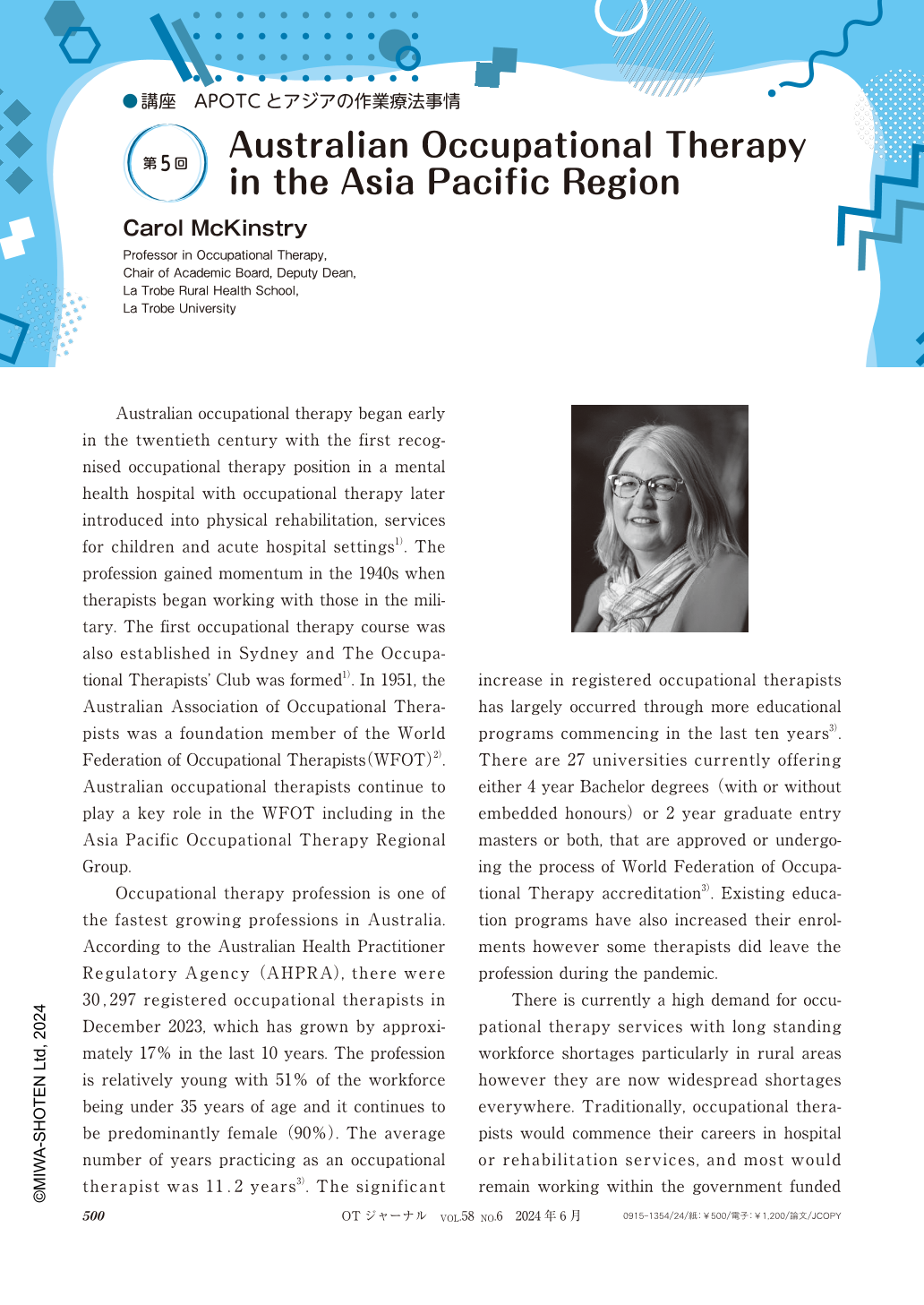Japanese
English
- 有料閲覧
- Abstract 文献概要
- 1ページ目 Look Inside
- 参考文献 Reference
Australian occupational therapy began early in the twentieth century with the first recognised occupational therapy position in a mental health hospital with occupational therapy later introduced into physical rehabilitation, services for children and acute hospital settings1). The profession gained momentum in the 1940s when therapists began working with those in the military. The first occupational therapy course was also established in Sydney and The Occupational Therapists' Club was formed1). In 1951, the Australian Association of Occupational Therapists was a foundation member of the World Federation of Occupational Therapists(WFOT)2). Australian occupational therapists continue to play a key role in the WFOT including in the Asia Pacific Occupational Therapy Regional Group.
Occupational therapy profession is one of the fastest growing professions in Australia. According to the Australian Health Practitioner Regulatory Agency(AHPRA), there were 30,297 registered occupational therapists in December 2023, which has grown by approximately 17% in the last 10 years. The profession is relatively young with 51% of the workforce being under 35 years of age and it continues to be predominantly female(90%). The average number of years practicing as an occupational therapist was 11.2 years3). The significant increase in registered occupational therapists has largely occurred through more educational programs commencing in the last ten years3). There are 27 universities currently offering either 4 year Bachelor degrees(with or without embedded honours)or 2 year graduate entry masters or both, that are approved or undergoing the process of World Federation of Occupational Therapy accreditation3). Existing education programs have also increased their enrolments however some therapists did leave the profession during the pandemic.
Australian occupational therapy began early in the twentieth century with the first recognised occupational therapy position in a mental health hospital with occupational therapy later introduced into physical rehabilitation, services for children and acute hospital settings1). The profession gained momentum in the 1940s when therapists began working with those in the military. The first occupational therapy course was also established in Sydney and The Occupational Therapists' Club was formed1). In 1951, the Australian Association of Occupational Therapists was a foundation member of the World Federation of Occupational Therapists(WFOT)2). Australian occupational therapists continue to play a key role in the WFOT including in the Asia Pacific Occupational Therapy Regional Group.
Occupational therapy profession is one of the fastest growing professions in Australia. According to the Australian Health Practitioner Regulatory Agency(AHPRA), there were 30,297 registered occupational therapists in December 2023, which has grown by approximately 17% in the last 10 years. The profession is relatively young with 51% of the workforce being under 35 years of age and it continues to be predominantly female(90%). The average number of years practicing as an occupational therapist was 11.2 years3). The significant increase in registered occupational therapists has largely occurred through more educational programs commencing in the last ten years3). There are 27 universities currently offering either 4 year Bachelor degrees(with or without embedded honours)or 2 year graduate entry masters or both, that are approved or undergoing the process of World Federation of Occupational Therapy accreditation3). Existing education programs have also increased their enrolments however some therapists did leave the profession during the pandemic.

Copyright © 2024, MIWA-SHOTEN Ltd., All rights reserved.


